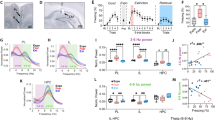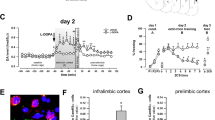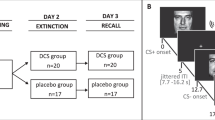Abstract
Antidepressant drugs are commonly prescribed treatments for anxiety disorders, and there is growing interest in understanding how these drugs impact fear extinction because extinction learning is pivotal to successful exposure-based therapy (EBT). A key objective within this domain is understanding how antidepressants alter the activation of specific elements of the limbic-based network that governs such fear processing. Chronic treatment with the antidepressant tianeptine has been shown to reduce the acquisition of extinction learning in rats, yet the drug’s acute influence on activation in prefrontal and amygdalar regions, and on extinction learning are not well understood. To assess its influence on cellular activation, rats were injected with tianeptine and Fos immunoreactivity was measured in these regions. Acute tianeptine treatment selectively altered Fos expression within subdivisions of the central nucleus of the amygdala (CEA) in a bidirectional manner that varied in relation to ongoing activation within the capsular subdivision and its prefrontal and intra-amygdalar inputs. This pattern of results suggests that the drug can conditionally modulate the activation of CEA subdivisions, which contain microcircuits strongly implicated in fear processing. The effect of acute tianeptine was also examined with respect to the acquisition, consolidation and expression of fear extinction in rats. Acute tianeptine attenuated extinction learning as well as the recall of extinction memory, which underscores that acute dosing with the drug could alter learning during EBT. Together these findings provide a new perspective for understanding the mechanism supporting tianeptine’s clinical efficacy, as well as its potential influence on CEA-based learning mechanisms.
This is a preview of subscription content, access via your institution
Access options
Subscribe to this journal
Receive 12 print issues and online access
$259.00 per year
only $21.58 per issue
Buy this article
- Purchase on Springer Link
- Instant access to full article PDF
Prices may be subject to local taxes which are calculated during checkout




Similar content being viewed by others

References
Ravindran LN, Stein MB . The pharmacologic treatment of anxiety disorders: a review of progress. J Clin Psychiatry 2010; 71: 839–854.
Bisson J, Andrew M . Psychological treatment of post-traumatic stress disorder (PTSD). Cochrane Database Syst Rev 2007; CD003388.
Karpova NN, Pickenhagen A, Lindholm J, Tiraboschi E, Kulesskaya N, Agustsdottir A et al. Fear erasure in mice requires synergy between antidepressant drugs and extinction training. Science 2011; 334: 1731–1734.
Hetrick SE, Purcell R, Garner B, Parslow R . Combined pharmacotherapy and psychological therapies for post traumatic stress disorder (PTSD). Cochrane Database Syst Rev 2010; CD007316.
Ressler KJ, Rothbaum BO, Tannenbaum L, Anderson P, Graap K, Zimand E et al. Cognitive enhancers as adjuncts to psychotherapy: use of D-cycloserine in phobic individuals to facilitate extinction of fear. Arch Gen Psychiatry 2004; 61: 1136–1144.
Defrance R, Marey C, Kamoun A . Antidepressant and anxiolytic activities of tianeptine: an overview of clinical trials. Clin Neuropharmacol 1988; 11: S74–S82.
Franciskovic T, Sukovic Z, Janovic S, Stevanovic A, Nemcic-Moro I, Roncevic-Grzeta I et al. Tianeptine in the combined treatment of combat related posttraumatic stress disorder. Psychiatr Danub 2011; 23: 257–263.
Wilde MI, Benfield P . Tianeptine. A review of its pharmacodynamic and pharmacokinetic properties, and therapeutic efficacy in depression and coexisting anxiety and depression. Drugs 1995; 49: 411–439.
Lepine JP, Altamura C, Ansseau M, Gutierrez JL, Bitter I, Lader M et al. Tianeptine and paroxetine in major depressive disorder, with a special focus on the anxious component in depression: an international, 6-week double-blind study dagger. Hum Psychopharmacol 2001; 16: 219–227.
Burghardt NS, Sullivan GM, McEwen BS, Gorman JM, LeDoux JE . The selective serotonin reuptake inhibitor citalopram increases fear after acute treatment but reduces fear with chronic treatment: a comparison with tianeptine. Biol Psychiatry 2004; 55: 1171–1178.
Burghardt NS, Bush DE, McEwen BS, LeDoux JE . Acute selective serotonin reuptake inhibitors increase conditioned fear expression: blockade with a 5-HT(2C) receptor antagonist. Biol Psychiatry 2007; 62: 1111–1118.
Alby J, Ferreri M, Cabane J, De Bodinat C, Dagens V . Efficacy of tianeptine for the treatment of major depression and dysthymia with somatic complaints. A comparative study versus fluoxetine. Annales De Psychiatrie 1993; 8: 136–144.
McEwen BS, Chattarji S, Diamond DM, Jay TM, Reagan LP, Svenningsson P et al. The neurobiological properties of tianeptine (Stablon): from monoamine hypothesis to glutamatergic modulation. Mol Psychiatry 2010; 15: 237–249.
Piroli GG, Reznikov LR, Grillo CA, Hagar JM, Fadel JR, Reagan LP . Tianeptine modulates amygdalar glutamate neurochemistry and synaptic proteins in rats subjected to repeated stress. Exp Neurol 2013; 241: 184–193.
Svenningsson P, Bateup H, Qi H, Takamiya K, Huganir RL, Spedding M et al. Involvement of AMPA receptor phosphorylation in antidepressant actions with special reference to tianeptine. Eur J Neurosci 2007; 26: 3509–3517.
Zhang H, Etherington LA, Hafner AS, Belelli D, Coussen F, Delagrange P et al. Regulation of AMPA receptor surface trafficking and synaptic plasticity by a cognitive enhancer and antidepressant molecule. Mol Psychiatry 2013; 18: 471–484.
Reznikov LR, Grillo CA, Piroli GG, Pasumarthi RK, Reagan LP, Fadel J . Acute stress-mediated increases in extracellular glutamate levels in the rat amygdala: differential effects of antidepressant treatment. Eur J Neurosci 2007; 25: 3109–3114.
Qi H, Mailliet F, Spedding M, Rocher C, Zhang X, Delagrange P et al. Antidepressants reverse the attenuation of the neurotrophic MEK/MAPK cascade in frontal cortex by elevated platform stress; reversal of effects on LTP is associated with GluA1 phosphorylation. Neuropharmacology 2009; 56: 37–46.
Burghardt NS, Sigurdsson T, Gorman JM, McEwen BS, LeDoux JE . Chronic antidepressant treatment impairs the acquisition of fear extinction. Biol psychiatry 2013; 73: 1078–1086.
Phelps EA, Delgado MR, Nearing KI, LeDoux JE . Extinction learning in humans: role of the amygdala and vmPFC. Neuron 2004; 43: 897–905.
Milad MR, Quirk GJ . Fear extinction as a model for translational neuroscience: ten years of progress. Annu Rev Psychol 2012; 63: 129–151.
Herman JP, Figueiredo H, Mueller NK, Ulrich-Lai Y, Ostrander MM, Choi DC et al. Central mechanisms of stress integration: hierarchical circuitry controlling hypothalamo-pituitary-adrenocortical responsiveness. Front Neuroendocrinol 2003; 24: 151–180.
Aggleton J (ed). The Amygdala: a Functional Analysis. Oxford University Press: London, 2000.
Quirk GJ, Garcia R, González-Lima F . Prefrontal mechanisms in extinction of conditioned fear. Biol Psychiatry 2006; 60: 337–343.
Rocher C, Spedding M, Munoz C, Jay TM . Acute stress-induced changes in hippocampal/prefrontal circuits in rats: effects of antidepressants. Cereb Cortex 2004; 14: 224–229.
Maviel T, Durkin TP, Menzaghi F, Bontempi B . Sites of neocortical reorganization critical for remote spatial memory. Science 2004; 305: 96–99.
Jolkkonen E, Pitkanen A . Intrinsic connections of the rat amygdaloid complex: projections originating in the central nucleus. J Comp Neurol 1998; 395: 53–72.
Paxinos G, Watson C . The Rat Brain in Stereotaxic Coordinates, 4th edn. Academic Press: San Diego, CA, USA, 1998.
Fanselow MS . Conditioned and unconditional components of post-shock freezing. Pavlov J Biol Sci 1980; 15: 177–182.
Abdi H . Z-scores. In: Salkind NJ (ed). Encyclopedia of Measurement and Statistics, vol. 3. Sage: Thousand Oaks, CA, USA, 2007, pp 1055–1058.
Pare D, Duvarci S . Amygdala microcircuits mediating fear expression and extinction. Curr Opin Neurobiol 2012; 22: 717–723.
Huber D, Veinante P, Stoop R . Vasopressin and oxytocin excite distinct neuronal populations in the central amygdala. Science 2005; 308: 245–248.
Herry C, Ciocchi S, Senn V, Demmou L, Muller C, Luthi A . Switching on and off fear by distinct neuronal circuits. Nature 2008; 454: 600–606.
Ciocchi S, Herry C, Grenier F, Wolff SB, Letzkus JJ, Vlachos I et al. Encoding of conditioned fear in central amygdala inhibitory circuits. Nature 2010; 468: 277–282.
Haubensak W, Kunwar PS, Cai H, Ciocchi S, Wall NR, Ponnusamy R et al. Genetic dissection of an amygdala microcircuit that gates conditioned fear. Nature 2010; 468: 270–276.
Busti D, Geracitano R, Whittle N, Dalezios Y, Mańko M, Kaufmann W et al. Different fear states engage distinct networks within the intercalated cell clusters of the amygdala. J Neurosci 2011; 31: 5131–5144.
Wolff SB, Gründemann J, Tovote P, Krabbe S, Jacobson GA, Müller C et al. Amygdala interneuron subtypes control fear learning through disinhibition. Nature 2014; 509: 453–458.
Li H, Penzo MA, Taniguchi H, Kopec CD, Huang ZJ, Li B . Experience-dependent modification of a central amygdala fear circuit. Nature Neurosci 2013; 16: 332–339.
Sun N, Cassell MD . Intrinsic GABAergic neurons in the rat central extended amygdala. J Comp Neurol 1993; 330: 381–404.
Dong YL, Fukazawa Y, Wang W, Kamasawa N, Shigemoto R . Differential postsynaptic compartments in the laterocapsular division of the central nucleus of amygdala for afferents from the parabrachial nucleus and the basolateral nucleus in the rat. J Comp Neurol 2010; 518: 4771–4791.
McDonald AJ . Cytoarchitecture of the central amygdaloid nucleus of the rat. J Comp Neurol 1982; 208: 401–418.
Chieng BC, Christie MJ, Osborne PB . Characterization of neurons in the rat central nucleus of the amygdala: cellular physiology, morphology, and opioid sensitivity. J Comp Neurol 2006; 497: 910–927.
Nitecka L, Ben-Ari Y . Distribution of GABA-like immunoreactivity in the rat amygdaloid complex. J Comp Neurol 1987; 266: 45–55.
Pitkanen A, Savander V, LeDoux JE . Organization of intra-amygdaloid circuitries in the rat: an emerging framework for understanding functions of the amygdala. Trends Neurosci 1997; 20: 517–523.
Bernard JF, Alden M, Besson JM . The organization of the efferent projections from the pontine parabrachial area to the amygdaloid complex: a phaseolus vulgaris leucoagglutinin (PHA-L) study in the rat. J Comp Neurol 1993; 329: 201–229.
McDonald AJ, Mascagni F, Guo L . Projections of the medial and lateral prefrontal cortices to the amygdala: a Phaseolus vulgaris leucoagglutinin study in the rat. Neuroscience 1996; 71: 55–75.
Royer S, Pare D . Bidirectional synaptic plasticity in intercalated amygdala neurons and the extinction of conditioned fear responses. Neuroscience 2002; 115: 455–462.
Vouimba RM, Munoz C, Diamond DM . Differential effects of predator stress and the antidepressant tianeptine on physiological plasticity in the hippocampus and basolateral amygdala. Stress 2006; 9: 29–40.
Pillai AG, Anilkumar S, Chattarji S . The same antidepressant elicits contrasting patterns of synaptic changes in the amygdala vs hippocampus. Neuropsychopharmacology 2012; 37: 2702–2711.
Pare D, Royer S, Smith Y, Lang EJ . Contextual inhibitory gating of impulse traffic in the intra-amygdaloid network. Ann N Y Acad Sci 2003; 985: 78–91.
O'Donnell P, Grace AA . Synaptic interactions among excitatory afferents to nucleus accumbens neurons: hippocampal gating of prefrontal cortical input. J Neurosci 1995; 15: 3622–3639.
Nicola SM, Surmeier DJ, Malenka RC . Dopaminergic modulation of neuronal excitability in the striatum and nucleus accumbens. Ann Revi Neurosci 2000; 23: 185–215.
Rosenkranz JA, Buffalari DM, Grace AA . Opposing influence of basolateral amygdala and footshock stimulation on neurons of the central amygdala. Biolo Psychiatry 2006; 59: 801–811.
Dalton GL, Wang YT, Floresco SB, Phillips AG . Disruption of AMPA receptor endocytosis impairs the extinction, but not acquisition of learned fear. Neuropsychopharmacology 2007; 33: 2416–2426.
Sah P, Faber E, De Armentia ML, Power J . The amygdaloid complex: anatomy and physiology. Physiolo Rev 2003; 83: 803–834.
Sotres-Bayon F, Bush DE, LeDoux JE . Acquisition of fear extinction requires activation of NR2B-containing NMDA receptors in the lateral amygdala. Neuropsychopharmacology 2007; 32: 1929–1940.
Pinard C, Mascagni F, McDonald A . Medial prefrontal cortical innervation of the intercalated nuclear region of the amygdala. Neuroscience 2012; 205: 112–124.
Sotres-Bayon F, Quirk GJ . Prefrontal control of fear: more than just extinction. Curr Opin Neurobiol 2010; 20: 231–235.
Knapska E, Maren S . Reciprocal patterns of c-Fos expression in the medial prefrontal cortex and amygdala after extinction and renewal of conditioned fear. Learn Mem 2009; 16: 486–493.
Muigg P, Hetzenauer A, Hauer G, Hauschild M, Gaburro S, Frank E et al. Impaired extinction of learned fear in rats selectively bred for high anxiety–evidence of altered neuronal processing in prefrontal-amygdala pathways. Eur J Neurosci 2008; 28: 2299–2309.
Maren S, Quirk GJ . Neuronal signalling of fear memory. Nat Rev Neurosci 2004; 5: 844–852.
Zoladz PR, Fleshner M, Diamond DM . Differential effectiveness of tianeptine, clonidine and amitriptyline in blocking traumatic memory expression, anxiety and hypertension in an animal model of PTSD. Prog Neuropsychopharmacol Biol Psychiatry 2013; 44: 1–16.
Acknowledgements
We thank MJ Sanders and CK Cain for their comments on the manuscript, and A Hambucken, E Davenas and A Eckmier for their technical assistance. BP Godsil was supported by fellowships from INSERM as well as financial support from IRS, Servier Company. B Bontempi was supported by funding from the Fondation pour la Recherche Médicale (FRM: DEQ20130326468), CNRS and University of Bordeaux. This work was partially funded by grants from INSERM and IRS.
Author information
Authors and Affiliations
Corresponding author
Ethics declarations
Competing interests
The authors declare that the research of BP Godsil, including salary, has been supported by grants from INSERM and IRS. TM Jay is employed by INSERM, and her research has been supported by grants from INSERM and IRS. M Spedding was employed by IRS and Les Labotaoires Servier. P Delegrange is currently employed by IRS and Les Labotaoires Servier. The remaining authors declare no conflict of interest.
Additional information
Supplementary Information accompanies the paper on the Molecular Psychiatry website
Supplementary information
Rights and permissions
About this article
Cite this article
Godsil, B., Bontempi, B., Mailliet, F. et al. Acute tianeptine treatment selectively modulates neuronal activation in the central nucleus of the amygdala and attenuates fear extinction. Mol Psychiatry 20, 1420–1427 (2015). https://doi.org/10.1038/mp.2014.169
Received:
Accepted:
Published:
Issue Date:
DOI: https://doi.org/10.1038/mp.2014.169


